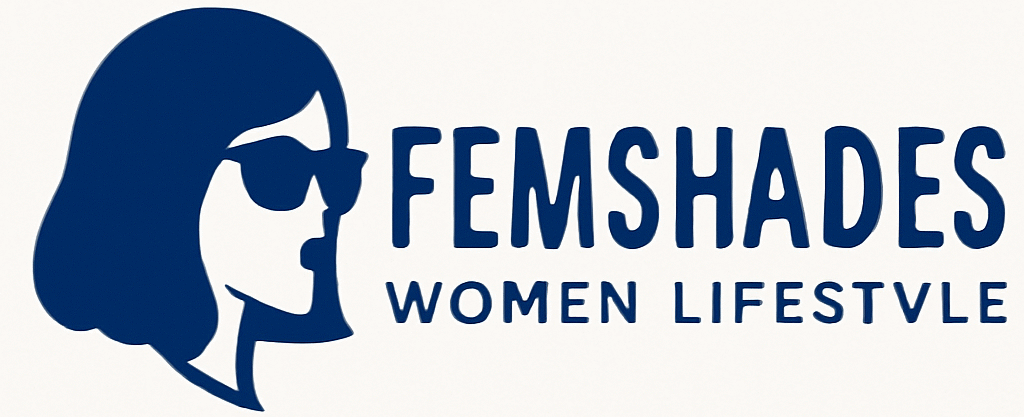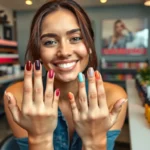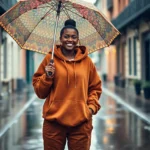Winter’s crisp air brings the perfect opportunity to transform your look with stunning hair colors that complement the season’s rich and moody aesthetic. We know that finding the right winter hair color as a Black woman means choosing shades that enhance your natural beauty while making a bold statement during the colder months.
The beauty of winter hair colors lies in their depth and sophistication – from luxurious burgundy and chocolate browns to striking copper tones and dramatic plums. These shades don’t just follow seasonal trends; they celebrate the unique undertones and textures of Black hair while providing that cozy winter vibe we’re all craving.
Whether you’re looking to make a subtle change or go for a complete hair transformation this winter we’ve got the insider knowledge to help you choose colors that’ll turn heads and boost your confidence throughout the season.
Deep Burgundy Shades That Command Attention
Deep burgundy transforms winter hair color choices for black women into stunning statements of elegance and power. These rich, wine-inspired hues create dramatic depth while maintaining sophistication throughout the colder months.
Wine Red Undertones for Warm Skin Tones
Wine red undertones complement warm skin tones beautifully by improving golden and bronze undertones naturally present in deeper complexions. We recommend testing these shades in natural lighting to ensure the perfect match with your skin’s warmth. Rich wine reds work exceptionally well on medium to dark skin tones, creating a harmonious blend that appears both natural and striking.
Professional colorists often suggest wine red burgundy for women with yellow or golden undertones in their skin. The depth of this shade prevents washing out darker complexions while adding warmth during winter’s harsh lighting conditions. Many clients find wine red undertones photograph beautifully in both indoor and outdoor winter settings.
Maroon Highlights on Natural Black Hair
Maroon highlights create stunning contrast against natural black hair without requiring full color commitment. We’ve seen incredible results when colorists place these highlights strategically around the face and crown area. The technique involves selecting small sections throughout the hair to add dimension and movement.
Partial highlighting with maroon shades costs significantly less than full color treatments while delivering maximum impact. Professional stylists recommend starting with subtle maroon highlights before progressing to more dramatic coverage. This approach allows you to test how the color interacts with your natural hair texture and maintenance routine.
Strategic placement of maroon highlights enhances natural curl patterns and adds visual interest to straight styles. The contrast between deep black and rich maroon creates depth that photographs beautifully under various lighting conditions.
Maintenance Tips for Burgundy Color
Color protecting shampoo extends burgundy hair color life by preventing premature fading and maintaining vibrancy. We recommend washing burgundy colored hair only 2-3 times per week with sulfate free formulas specifically designed for color treated hair. Cold water rinses help seal the hair cuticle and lock in color molecules.
Deep conditioning treatments become essential for maintaining burgundy shades, as darker colors require more processing time during application. Schedule professional touch ups every 6-8 weeks to maintain rich color saturation and prevent root growth from becoming noticeable. UV protection products shield burgundy hair from sun damage that can cause unwanted color shifts.
Weekly protein treatments strengthen hair damaged during the coloring process while maintaining elasticity. Professional toners applied every 4-6 weeks refresh burgundy tones and eliminate any brassiness that may develop over time.
Rich Chocolate Brown Tones for Versatile Styling
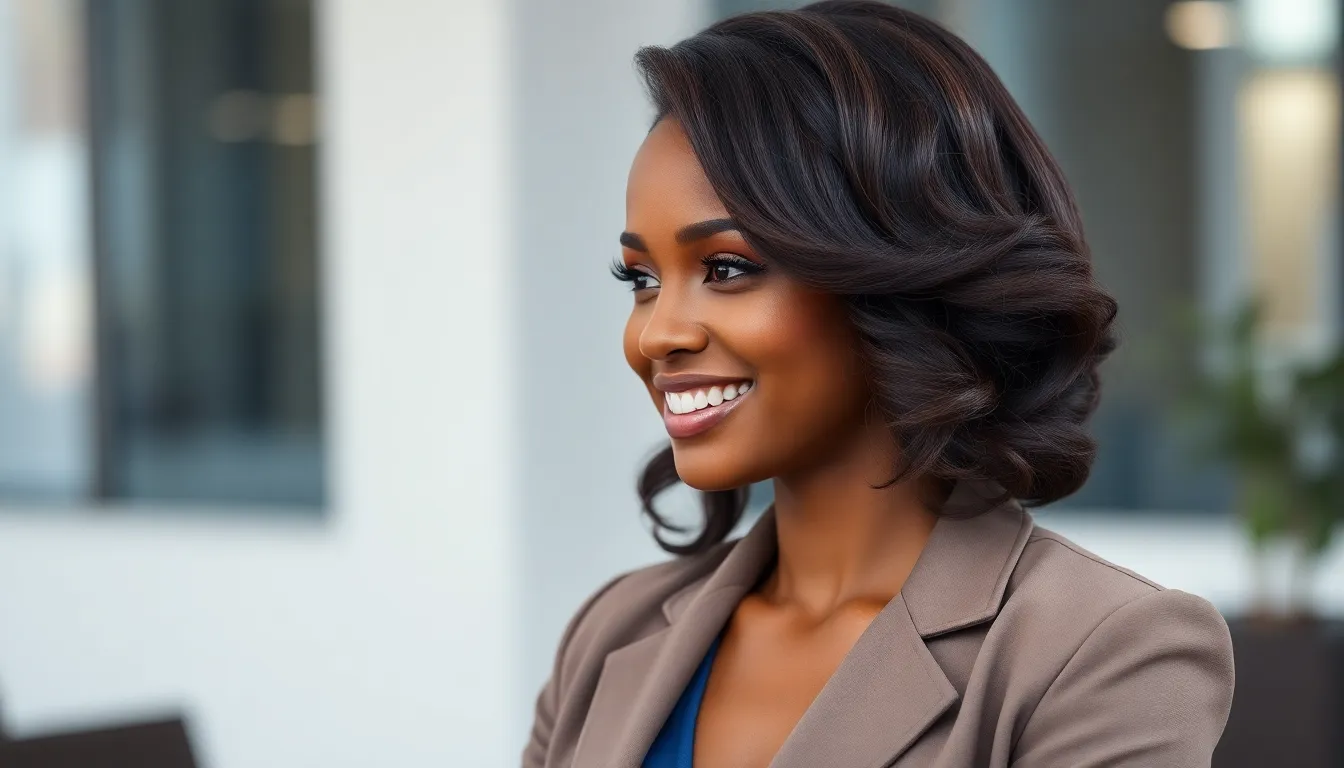
Rich chocolate brown transforms winter hair goals into achievable reality for Black women. This sophisticated shade bridges the gap between natural and dramatic, offering endless styling possibilities throughout the colder months.
Espresso Brown for Professional Settings
Espresso brown delivers sophisticated elegance that commands respect in professional environments. This darker chocolate variant creates a polished appearance that transitions seamlessly from boardroom meetings to evening networking events.
Corporate settings benefit from espresso brown’s timeless appeal, as it maintains professionalism while showcasing personal style. The depth of this shade complements power suits and business casual attire equally well.
Professional women appreciate espresso brown’s low maintenance requirements compared to lighter shades. This color choice withstands daily styling routines while maintaining its rich, glossy finish that photograph beautifully under office lighting.
Milk Chocolate Highlights for Dimension
Milk chocolate highlights elevate darker base colors by adding strategic dimension and warmth. These lighter brown accents create visual interest without overwhelming natural hair tones, perfect for women seeking subtle enhancement.
Strategic placement of milk chocolate highlights around the face brightens complexions and adds youthful vitality. Face framing highlights draw attention to eyes and cheekbones while maintaining the integrity of the overall chocolate brown palette.
Textured hairstyles showcase milk chocolate highlights most effectively, as the varying tones create depth in curls and waves. Natural movement in the hair allows these highlights to catch light dynamically, creating a multi dimensional effect that appears expensive and professionally done.
Color-Safe Products for Brown Tones
Color safe products preserve the vibrancy of chocolate brown shades throughout winter’s harsh conditions. Sulfate free shampoos prevent color stripping while maintaining the hair’s natural moisture balance essential for healthy brown tones.
Deep conditioning treatments specifically formulated for color treated hair extend the life of chocolate brown shades. These products contain ingredients that seal the hair cuticle, locking in color molecules and preventing premature fading.
Professional grade color protecting conditioners create a barrier against environmental stressors that can dull brown tones. Weekly treatments with these specialized products maintain the glossy finish that makes chocolate brown appear salon fresh between appointments.
Bold Copper and Auburn Hues for Statement Looks
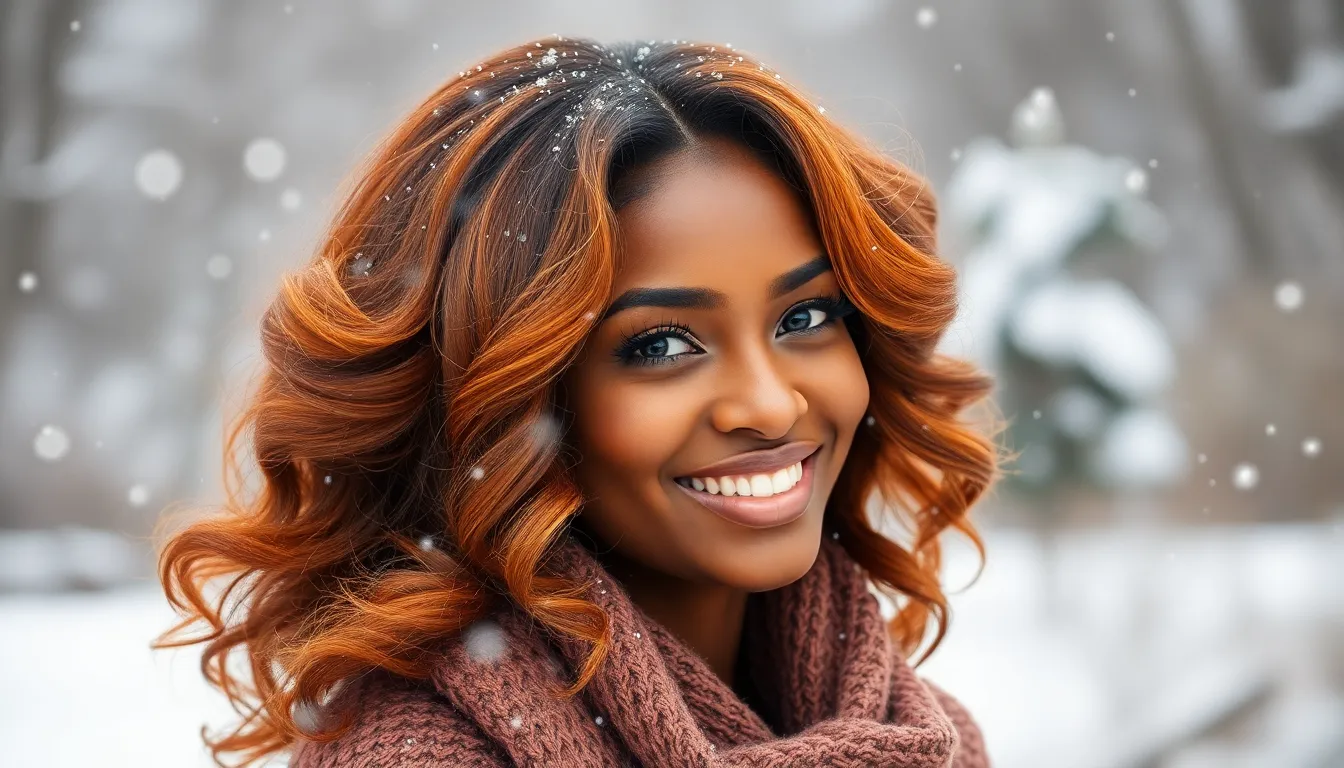
Winter’s colder months call for hair colors that create drama and warmth against deeper skin tones. Copper and auburn deliver that perfect combination of vibrancy and sophistication, offering rich undertones that range from bright penny copper to deep mahogany.
Copper Penny Shades for Golden Undertones
Copper penny shades bring a metallic sheen that’s particularly flattering for Black women with warm, golden undertones. This golden hue brightens your complexion naturally while adding the perfect amount of warmth during winter’s cooler days. We love how copper penny works beautifully with both short pixie cuts and flowing long styles, creating versatility that matches any personal aesthetic. The metallic quality of this shade catches light beautifully, giving your hair movement and dimension that photographs gorgeously in winter’s softer lighting.
Auburn Balayage Techniques
Auburn balayage offers the perfect application method for those wanting a natural, sun-kissed effect with lower maintenance requirements. This technique blends darker roots seamlessly into lighter auburn ends, creating a gradient that reduces harsh demarcation lines. We recommend auburn balayage because it requires fewer touch-ups compared to full-color treatments, making it ideal for busy schedules. The hand-painted application adds depth and movement to layered cuts and enhances the natural texture of curly styles, creating dimension that works with your hair’s natural flow.
Protecting Red-Based Colors from Fading
Red-based colors like copper and auburn require special care because their large pigment molecules make them prone to fading faster than other shades. We always recommend using sulfate-free shampoos and rinsing with cold water to lock in color vibrancy. Color-protecting conditioners become essential for maintaining the richness of these statement hues between salon visits. Limiting heat styling and sun exposure helps preserve your investment, while scheduling regular gloss treatments every 6-8 weeks refreshes the color’s intensity and shine.
Sophisticated Plum and Eggplant Colors
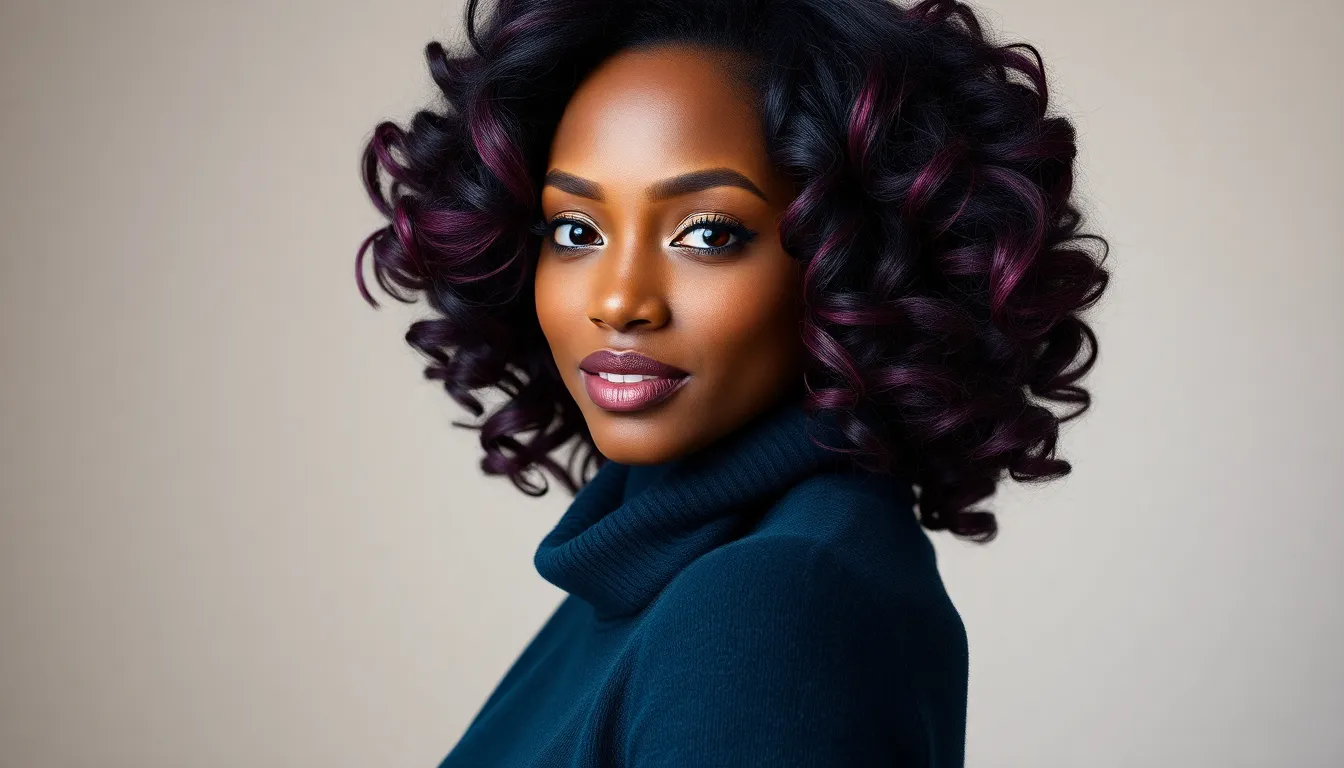
Plum and eggplant shades bring jewel-toned sophistication to winter hair transformations. These rich, deep colors create dramatic elegance while improving the natural beauty of darker skin tones.
Deep Purple Undertones for Cool Skin
Purple undertones create stunning contrast that highlights the natural beauty of black women’s skin. Deep purple shades add remarkable depth and dimension to your overall look during winter months. While these colors are traditionally associated with cool skin tones, they complement darker complexions by creating visual interest and sophistication. Rich purple undertones work exceptionally well when you want to make a bold statement without compromising professional appearance.
Plum Ombre Styling Options
Plum ombre offers versatile styling that transitions beautifully from darker roots to lighter plum ends. This technique works particularly well with curly or wavy hair textures, adding visual interest and movement to your style. We recommend starting with subtle plum highlights before committing to full ombre for those new to jewel tones. Strategic placement of plum color creates depth without overwhelming your natural hair color, making it perfect for winter styling experiments.
Winter-Appropriate Purple Maintenance
Sulphate-free shampoos preserve the vibrancy of plum and eggplant colors during harsh winter conditions. Silicone-free conditioners prevent color fade while keeping your hair healthy throughout the season. Regular moisturizing treatments become essential to counteract dryness from both cold weather and color processing. We suggest deep conditioning treatments weekly to maintain color integrity and hair health. Color-preserving products specifically designed for purple tones help extend the life of your jewel-toned winter look.
Warm Caramel and Honey Blonde Highlights
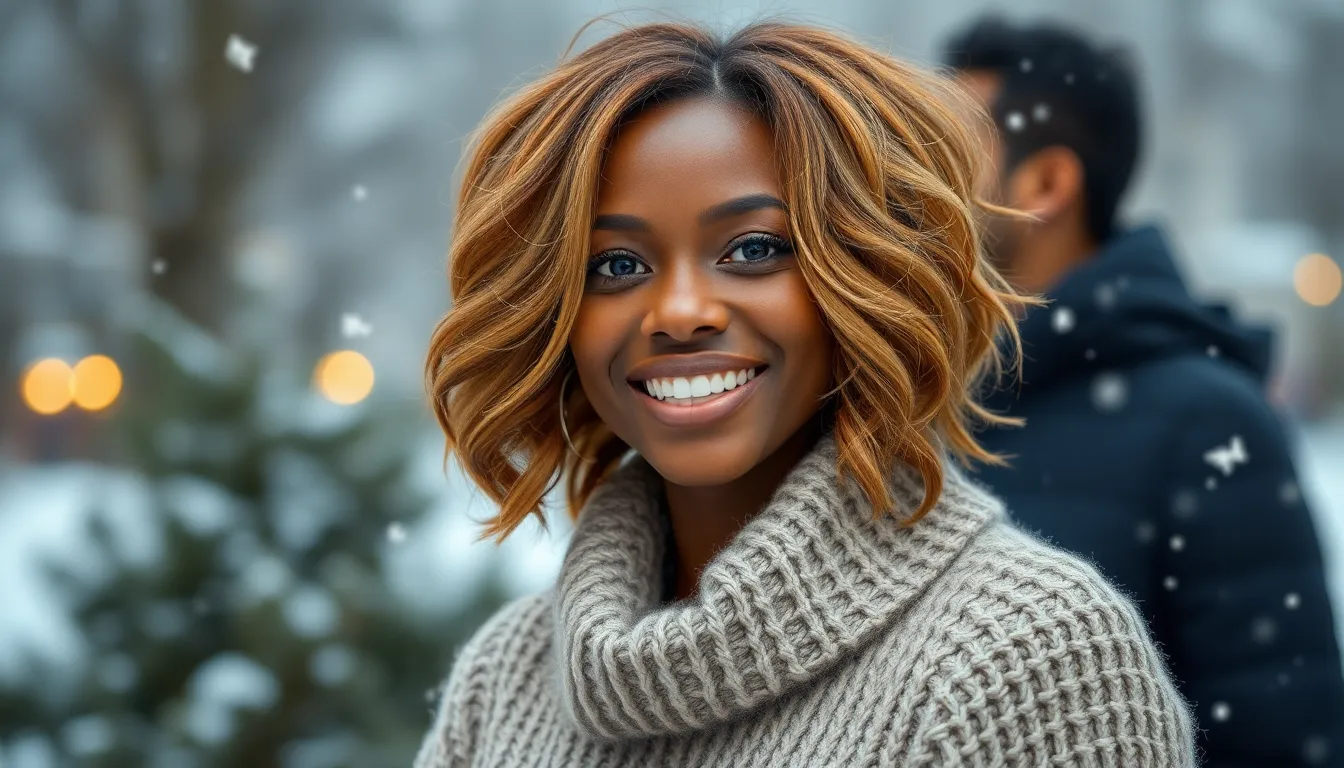
Warm blonde tones create stunning contrast against deeper skin tones during winter months. These golden hues add brightness and warmth to your look when the weather turns cold.
Golden Caramel for Natural Dimension
Golden caramel tones transform your hair by creating multi-dimensional layers that enhance natural texture. We recommend this shade for its ability to complement the inherent beauty of Black hair while adding sophisticated depth. Natural dimension emerges when caramel highlights catch light at different angles throughout the day. Styling versatility increases with golden caramel since it works beautifully with protective styles like braids, twists, and natural curls. Professional colorists often suggest starting with subtle caramel pieces before committing to a full transformation.
Honey Blonde Face-Framing Pieces
Honey blonde highlights strategically placed around your face create an elegant frame that brightens your complexion. We’ve seen this technique add instant radiance while maintaining the natural beauty of darker base colors. Face framing pieces work exceptionally well because they draw attention to your best features without overwhelming your overall look. Strategic placement by experienced stylists ensures the honey blonde complements your skin’s undertones perfectly. Bold combinations become possible when you pair honey blonde face framing highlights with other warm tones for a striking winter appearance.
Blonde Maintenance in Cold Weather
Blonde hair requires extra attention during winter months due to increased dryness from cold temperatures and indoor heating. We recommend implementing a consistent moisturizing routine that includes weekly hydrating hair masks to preserve color vibrancy. Protective styling becomes essential for maintaining the health of blonde treated hair during harsh weather conditions. Heat styling should be minimized to prevent further damage and color fading throughout the winter season. Color protecting products specifically formulated for blonde hair help maintain the integrity of caramel and honey tones while fighting environmental stressors.
Trendy Blue-Black and Jet Black Options
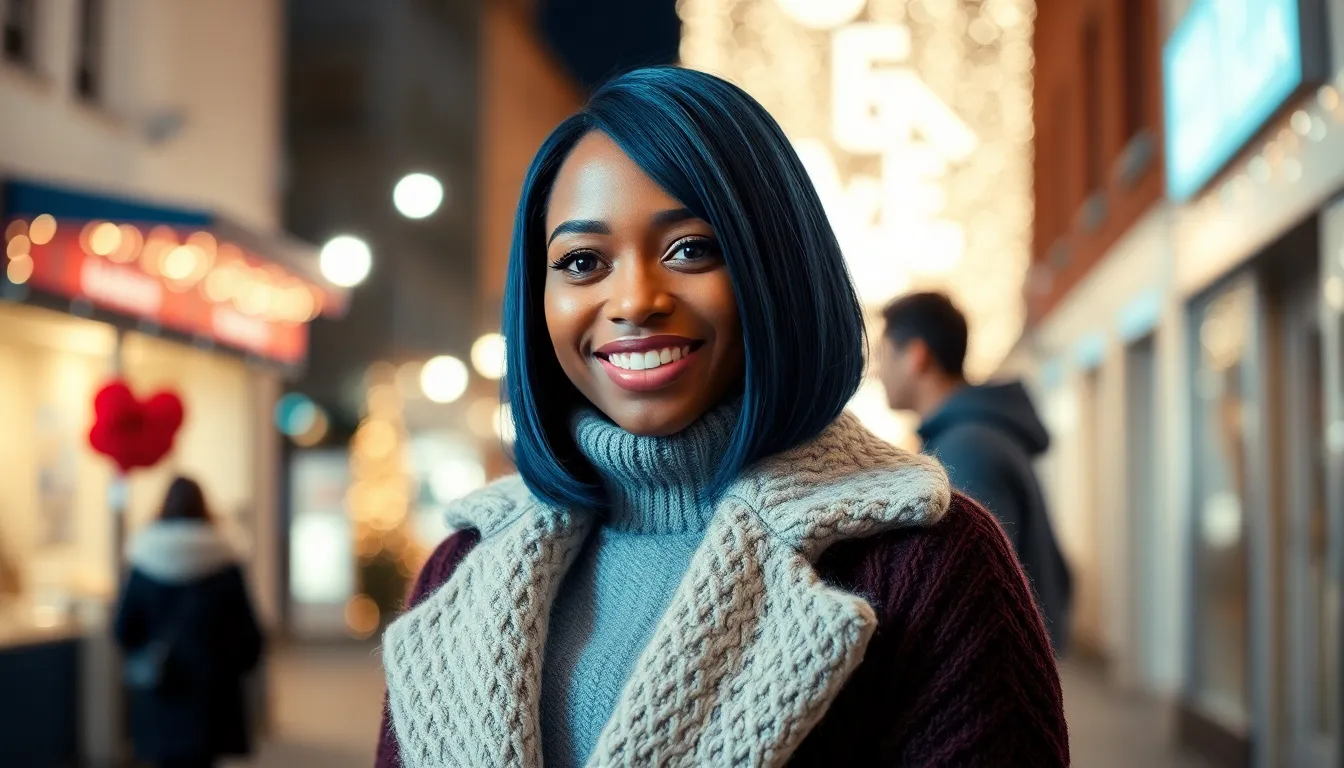
Blue black and jet black represent the epitome of winter sophistication for Black women seeking timeless elegance. These deeper variations of natural black create stunning visual impact while maintaining professional versatility.
Blue-Black for High Shine and Depth
Blue black delivers exceptional shine that catches light beautifully in winter’s shorter days. This sophisticated shade adds remarkable depth to your natural hair color without requiring dramatic maintenance changes. The subtle blue undertones create a multidimensional effect that appears different under various lighting conditions.
Professional colorists recommend blue black for women with cool undertones in their complexion. The high shine finish makes this shade particularly striking against deeper skin tones. Blue black works exceptionally well with sleek styles like bobs, long layers, and protective updos that showcase the glossy finish.
Maintaining blue black requires color protecting shampoos formulated specifically for dark hair. Deep conditioning treatments every two weeks help preserve the lustrous appearance. Cold water rinses prevent color fading and enhance the natural shine that makes this shade so appealing.
Jet Black for Classic Winter Elegance
Jet black provides timeless sophistication that never goes out of style during winter months. This pure black shade offers classic elegance that transitions seamlessly from professional settings to evening events. The rich, solid color creates striking contrast against all skin tones.
Styling versatility makes jet black an excellent choice for women who frequently change their hairstyles. The uniform color provides a perfect backdrop for accessories like headbands, scarves, and jewelry. Jet black complements winter wardrobes filled with rich fabrics and deeper colors.
Professional application ensures even coverage and prevents patchy results. Regular touch ups every 6 to 8 weeks maintain the solid color integrity. Sulfate free products protect the color while keeping hair healthy throughout the winter season.
Improving Natural Black Hair Color
Natural black hair benefits significantly from subtle enhancements that add dimension without dramatic changes. Balayage techniques create depth by painting color onto selected sections rather than applying all over color. This method preserves hair health while adding visual interest to your natural shade.
Caramel and honey blonde highlights bring warmth to natural black hair during colder months. These lighter accents create beautiful contrast while maintaining the integrity of your base color. Strategic placement around the face brightens your complexion and adds movement to your hairstyle.
Professional colorists can assess your natural undertones to determine the best enhancement options. Glossing treatments add shine to natural black hair without permanent color commitment. Regular deep conditioning maintains hair health while improving your natural beauty throughout winter.
Professional Hair Coloring vs. At-Home Options
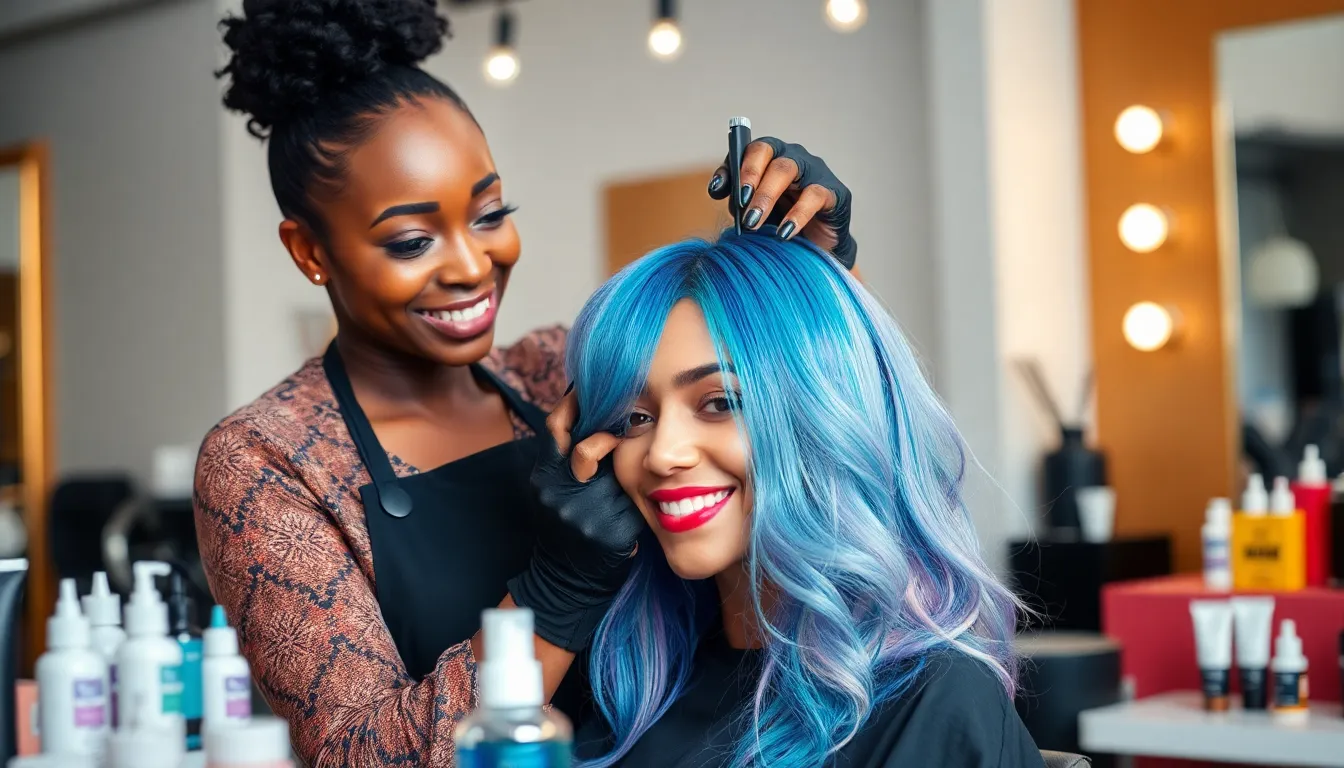
Choosing between professional services and DIY coloring can significantly impact your winter hair transformation results. We’ll explore the key factors that determine which option suits your exact needs and goals.
When to Visit a Professional Colorist
Customized color matching becomes essential when you’re seeking precision for winter shades like icy blonde or cinnamon brown. Professional colorists assess your skin tone’s undertones to ensure your chosen winter color enhances rather than clashes with your natural complexion.
Bold transformations require expert application, particularly for vibrant options like bright copper or metallic gray highlights. These complex colors demand technical skill to achieve even saturation and prevent unwanted color results that could damage your hair’s integrity.
Sensitive or previously treated hair benefits from professional care during the coloring process. Colorists can apply protective treatments and adjust formulations to minimize damage while achieving your desired winter look safely.
Multi dimensional techniques like balayage or ombre in plum and eggplant shades require artistic placement that professionals master through training and experience. These gradient effects create the sophisticated depth that makes winter colors particularly striking on Black women.
Safe At-Home Coloring Products
Conditioning formulas should be your priority when selecting at-home winter color products. Look for ingredients like argan oil, shea butter, and keratin that nourish your hair while depositing color.
Ammonia free options reduce scalp irritation and hair damage, making them safer choices for achieving winter shades at home. These gentler formulations work particularly well for subtle color changes or temporary transformations.
Semi permanent dyes offer the perfect solution for experimenting with winter colors without long term commitment. These products typically last 4-6 weeks and gradually fade, allowing you to test different shades throughout the season.
Color depositing shampoos help maintain your winter color between touch ups while adding subtle tones. These products work exceptionally well for refreshing burgundy, copper, or chocolate brown shades at home.
Cost Considerations for Winter Touch Ups
Professional services typically range from $150-$400 depending on your location and the complexity of your chosen winter color. Maintenance appointments every 6-8 weeks help preserve vibrant shades like bright copper or icy blonde.
At-home kits cost between $10-$30 per application, making them budget friendly for regular touch ups. But, achieving professional level results may require multiple attempts and additional products.
| Service Type | Initial Cost | Touch-Up Frequency | Monthly Average |
|---|---|---|---|
| Professional Coloring | $150-$400 | 6-8 weeks | $75-$200 |
| At-Home Kits | $10-$30 | 4-6 weeks | $20-$45 |
Long term investment considerations favor professional services for complex winter colors, while at-home options work well for simple maintenance and temporary color experiments.
Protecting Colored Hair During Winter Months
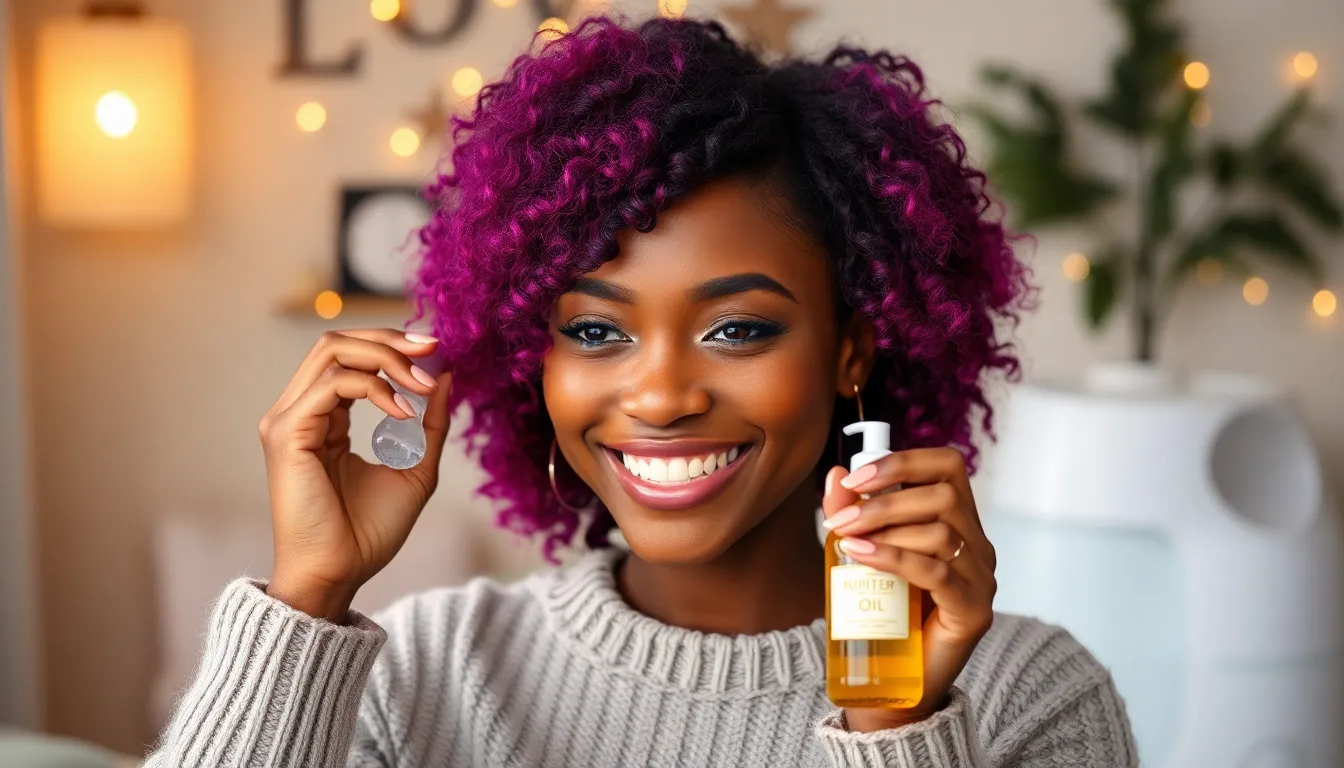
Winter weather presents unique challenges for maintaining vibrant colored hair, especially for Black women who’ve invested in stunning seasonal transformations. We’ll explore essential protection strategies to keep your winter hair color looking fresh and healthy throughout the colder months.
Moisture Retention for Colored Hair
Colored hair requires extra moisture during winter to prevent dryness and color fade. We recommend incorporating leave-in conditioners or nourishing hair oils into your daily routine to maintain optimal hydration levels. Deep conditioning treatments become crucial during this season, as they repair damage while protecting your hair from winter’s harsh effects.
Regular moisturizing treatments help preserve the vibrancy of your winter color investment. We suggest using products specifically formulated for color-treated hair, as these contain ingredients that seal the hair cuticle and lock in both moisture and color pigments.
Heat Protection from Indoor Heating
Indoor heating systems can strip moisture from colored hair more aggressively than natural winter air. We always recommend using heat protectant products when styling with blow dryers, flat irons, or curling tools to minimize damage and color fading.
Central heating creates an environment that constantly pulls moisture from your hair strands. We suggest keeping a humidifier in your bedroom or main living areas to add moisture back into the air, which helps maintain your hair’s natural hydration levels.
Seasonal Hair Care Routine Adjustments
Deep conditioning treatments should become a weekly priority rather than an occasional treat during winter months. We recommend using intensive moisture masks that specifically target color-treated hair to maintain both health and vibrancy.
Nighttime care becomes especially important when protecting colored hair from winter damage. We suggest sleeping on satin or silk pillowcases to prevent moisture loss and reduce friction that can cause breakage and color fading.
Scalp care deserves special attention during winter, as dry indoor air can cause itchiness and flaking. We recommend using nourishing scalp treatments and gentle massage techniques to promote healthy circulation and maintain comfort throughout the season.
Conclusion
Winter’s the perfect season for Black women to experiment with rich hair colors that celebrate our natural beauty. Whether we’re drawn to deep burgundy tones or sophisticated chocolate browns these seasonal shades offer endless possibilities for self-expression.
We’ve explored everything from bold copper hues to elegant plum shades each designed to complement our unique skin tones and personal style. The key lies in choosing colors that make us feel confident while maintaining healthy hair throughout the colder months.
Remember that proper maintenance and professional guidance can make all the difference in achieving our desired results. With the right approach winter hair color transforms become an empowering journey of beauty and creativity.
Frequently Asked Questions
What are the best winter hair colors for Black women?
The best winter hair colors for Black women include deep burgundy, rich chocolate brown, bold copper and auburn, sophisticated plum and eggplant, warm caramel and honey blonde highlights, and classic blue-black or jet black. These shades enhance natural beauty while making bold seasonal statements that complement deeper skin tones.
How do I choose the right burgundy shade for my skin tone?
Wine red undertones work best for warm skin tones, enhancing golden and bronze undertones in deeper complexions. Test burgundy shades in natural light for the best match. Consider maroon highlights on natural black hair for contrast without full color commitment, focusing on strategic placement for maximum impact.
What makes chocolate brown a good winter hair color choice?
Chocolate brown offers versatility and sophistication for winter. Espresso brown provides a polished, professional appearance that transitions well from day to night with low maintenance requirements. Milk chocolate highlights add dimension and warmth to darker base colors without overwhelming natural hair tones.
How should I maintain burgundy hair color?
Maintain burgundy color by using color-protecting shampoos and deep conditioning treatments. Schedule regular professional touch-ups to maintain vibrancy and prevent fading. Avoid harsh sulfates and use products specifically designed for color-treated hair to preserve the rich burgundy tones.
Are copper and auburn colors suitable for all Black women?
Copper and auburn hues work particularly well with warm, golden undertones, adding brightness to the complexion. Copper penny shades offer metallic sheen and versatility with various hairstyles. Auburn balayage provides a natural, sun-kissed effect with lower maintenance while blending seamlessly from darker roots.
What special care do red-based hair colors require?
Red-based colors like copper and auburn need special care to prevent fading. Use sulfate-free shampoos, rinse with cold water, and apply color-protecting conditioners. These colors fade faster than others, so consistent maintenance with appropriate products is essential for longevity.
How do plum and eggplant colors work for winter?
Plum and eggplant colors bring jewel-toned elegance perfect for winter transformations. Deep purple undertones create dramatic contrast and enhance natural beauty. Consider plum ombre styling for experimentation, transitioning beautifully from darker roots to lighter ends for a sophisticated gradient effect.
Can I add blonde highlights to dark hair in winter?
Yes, warm caramel and honey blonde highlights create stunning contrast against deeper skin tones in winter. Golden caramel tones enhance natural texture while honey blonde face-framing pieces brighten the complexion. These highlights add sophisticated depth without overwhelming your natural color.
What’s the difference between blue-black and jet black hair?
Blue-black offers exceptional shine and depth, particularly flattering for women with cool undertones. Jet black provides timeless elegance that transitions seamlessly from professional to evening settings. Both represent winter sophistication but blue-black has subtle blue undertones while jet black is pure black.
Should I go to a professional colorist or color at home?
Choose professional services for customized color matching, bold transformations, complex techniques like balayage, or if you have sensitive or previously treated hair. At-home options work for simple maintenance, temporary changes, or experimentation with semi-permanent dyes and conditioning formulas.
How do I protect colored hair during winter?
Protect colored hair by using leave-in conditioners and deep conditioning treatments for moisture retention. Apply heat protectant products and use humidifiers to combat indoor heating effects. Adjust your routine with weekly deep conditioning, satin pillowcases, and nourishing scalp treatments.
What products should I avoid with colored hair?
Avoid sulfate-containing shampoos, harsh chemicals, and hot water which can strip color and cause fading. Skip silicone-heavy products that can build up and dull shine. Instead, choose color-safe, sulfate-free formulas and lukewarm water for washing to preserve vibrancy.
